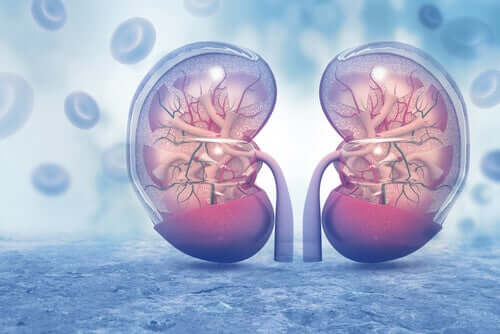Polyuria - Characteristics and Treatments


Written and verified by the doctor Leonardo Biolatto
Polyuria is a medical term to refer to an increase in urine production. An adult gets this diagnosis if their body produces more than three liters of urine per day. For children, it’s more than two and a half liters in twenty-four hours.
There are other similar terms that don’t really mean the same. For example, pollakiuria is when a person urinates several times a day but their total amount of fluid is normal. Similarly, there’s nocturia, which happens when a person must interrupt their sleep to urinate at night.
There may be polyuria with nocturia or polyuria with pollakiuria, but they’re not the same. In addition, there can be an increase in urine volume without another accompanying sign as well. In any case, this is merely a symptom and not a disease in itself. Thus, to find out what’s the underlying disease, you must obtain a diagnosis.
The amount of urine produced in twenty-four hours depends on three factors:
- How much liquid enters your body
- The substances that the body must eliminate. This is because urine is a human body mechanism with which it removes any elements it doesn’t need. The excreted amount is also a factor.
- Renal functioning, as urine is a product of the kidneys and depends on their ability to function properly
General causes of polyuria
Firstly, let’s name the general causes of polyuria so we can explain the diseases that are the most frequent cause of this symptom later, in more detail. Some causes are due to everyday events while others are more persistent:
- Increased fluid intake: Obviously, the more fluids you drink in a day, the more your body will have to eliminate. Here a person will face temporary, benign polyuria.
- Increased salt consumption: Salt is a substance that can drag water, that is, it absorbs the body’s water and takes it along to the kidneys for these to expel it from the body. When a person ingests very salty food they can expect an increase in the volume of urine. This is also a momentary form of polyuria.
- Urine-stimulating drinks: Certain liquids such as beer, some teas, and caffeine can increase the volume of urine.
- Cold surroundings: When the environment is cold, the body registers it and it leads to vasoconstriction which means the diameter of the body’s arteries decreases. By narrowing the arteries, there’s less room for the blood, and thus the only way to get rid of any excess fluid is to up the production of urine.
- Use of diuretics: Doctors prescribe diuretics such as furosemide or hydrochlorothiazide for some pathologies. This is because these drugs increase the volume of urine and lead to polyuria. It’s a common side effect.

Read also: What Is a Diuretic and What Is it For?
Specific diseases that lead to polyuria
After describing the general causes, we’ll now name four diseases in which polyuria is a common symptom. Medical control is very important in these diseases as polyuria can be a huge problem.
Even though polyuria is another symptom in the context of these pathologies, it causes extra problems when it gets out of control. Even so, the main goal will always be to solve the underlying disease.
Diabetes
This is one of the most common causes of polyuria, in terms of diseases. It’s common for the triad of polyuria, polydipsia (increased thirst), and polyphagia (increased appetite) to be the initial warnings of this condition.
Polyuria responds to the body’s need to get rid of excess glucose, as per the diabetic condition. With so much sugar circulating in the blood, the only way to escape is to excrete it with the urine, thus increasing its production. Hence the classic polyuria of these patients.
Heart failure
The heart is unable to pump the necessary amount of blood to the entire body. So, it becomes an insufficient organ because it doesn’t have enough strength to execute the contractions.
It’s common for people with heart failure to have polyuria because the failure in the circulatory process leads to the accumulation of fluids. Thus, the body removes the excess fluid through the urine, often increasing the volume at night.

Check out: Your Health and Urine – 8 Different Types
Arterial hypertension
People with hypertension present an increase in the amount of urine when they’re not under medication, or when the control of their disease isn’t appropriate. Sometimes, polyuria is the only sign in the presence of a silent disease such as high blood pressure.
High blood pressure values affect the kidneys function, changing the way a body filters blood and produces urine. Thus, it increases production. In addition, there’s also involvement from mechanisms that are similar to those of heart failure.
Polyuria and renal insufficiency
Generally, there aren’t many people with kidney failure but the pathology is quite serious. In these cases, the kidneys aren’t enough because they’re not able to adequately filter the blood for proper urine production. In the light of such poor filtration, the body doesn’t only lose those substances that must go out of the body but also the useful ones like water, among others.
Renal insufficiency can be a final and complicated stage of other pathologies, such as diabetes, or an entity resulting from poorly resolved infections, autoimmune attacks from the organism, and even malignant tumors.
Conclusion
Polyuria is a symptom worth paying attention to. However, if you’ve eaten salty food or you’ve been exposed to cold temperatures, then there’s nothing to worry about. Just wait for it to go away on its own. However, you must consult your doctors if it’s persistent.
Medical professionals will do the necessary studies they need to make a diagnosis and get to the root of the polyuria problem. Once they find the cause, they’ll establish the necessary treatment.
All cited sources were thoroughly reviewed by our team to ensure their quality, reliability, currency, and validity. The bibliography of this article was considered reliable and of academic or scientific accuracy.
- Grimaldi, A. “Polidipsia-poliuria.” EMC-Tratado de Medicina 16.2 (2012): 1-2.
- Biagetti, B., I. Vinagre, and S. M. Webb. “Protocolo diagnóstico del síndrome de poliuria y polidipsia.” Medicine-Programa de Formación Médica Continuada Acreditado 10.13 (2008): 883-885.
- Guinea, M. Torres, and Gabriel de Arriba de la Fuente. “Protocolo diagnóstico de la poliuria.” Medicine: Programa de Formación Médica Continuada Acreditado 10.80 (2011): 5435-5437.
This text is provided for informational purposes only and does not replace consultation with a professional. If in doubt, consult your specialist.








